Effectiveness of Petai (Parkia speciosa) Ethanol Extract in Controlling Foam Cell Numbers in Atherosclerosis-Induced Male Wistar Rats
DOI:
https://doi.org/10.22219/sm.Vol20.SMUMM1.38652Abstract
Atherosclerosis is a chronic inflammatory disease that causes the narrowing of the arterial lumen, and it is considered the primary cause of cardiovascular diseases such as myocardial infarction (MI), heart failure, and stroke. Cardiovascular disease is the leading of death globally. Atherosclerosis has a complex pathophysiology, such as endothelial dysfunction, thickening of the tunica intima, and the formation of atheromatous plaques. After that process, foam cells will form, which is the key to the development of atherosclerosis. Petai ethanol extract contains antioxidants, which are flavonoids, saponins, and tannins, that can reduce the number of Low-Density lipoproteins (LDL). The purpose of this study was to evaluate the effect of petai ethanol extract on the number of atherosclerotic foam cells in male white rats (Rattus norvegicus strain wistar) induced by lard. The method of this study was a genuinely experimental and post-test-only control group design with 25 rats divided into five control groups, which are one negative control group, one positive control group, and three treatment groups with extract doses of 100mg/kgBW, 200mg/kgBW and 400mg/kgBW. Observation of foam cells was carried out using a microscope with 400x magnification. Data were analyzed using Oneway ANOVA and Post Hoc Tamhane's test. The results of the study using the Oneway ANOVA test showed that there were significant differences between groups (p: 0.000). Post Hoc Tamhane's test between the positive control group and treatment groups 1, 2, and 3 can be seen that there is a significant difference between the formation of foam cells due to the administration of petai ethanol extract compared to positive control (p <0.05). This study concludes that Petai ethanol extract was effective in reducing the number of atherosclerotic foam cells formed.
Downloads
References
Artha, C., Mustika, A. and Sulistyawati, S. W. 2017. Pengaruh Ekstrak Daun Singawalang terhadap Kadar LDL Tikus Putih Jantan Hiperkolesterolemia Singawalang Leaf Extract Effects on LDL Levels of Hypercholesterolemic Male Rats’, 5(2), pp. 105–109.
Ekananda, N. A. 2015. [Artikel Review] Bay Leaf in Dyslipidemia Therapy’, Dyslipidemia Therapy J MAJORITY |, 4, p. 64.
Frostegård, J. (2013). Peripheral Neuropathy and HIV - VA National HIV/AIDS Website’, pp. 1–8. Available at: http://www.biomedcentral.com/1741-7015/11/117%0Apapers3://publication/uuid/D0C88CBA-A315-4DF2-8BF5 CD34F24146B2.
Gupta, K. K., Ali, S. and Sanghera, R. S. 2019. Pharmacological Options in Atherosclerosis: A Review of the Existing Evidence. Cardiology and Therapy, 8(1), pp. 5–20. doi: 10.1007/s40119-018-0123-0.
Kamisah, Y., Othman, F., Qodriyah, M. S. et al. 2013. Parkia speciosa Hassk.: Apotential phytomedicine. Evidence-based Complementary and Alternative Medicine, 2013. doi: 10.1155/2013/709028.
Kementerian Kesehatan RI. 2018. Laporan Riskesdas 2018. Laporan Nasional RIskesdas 2018, 53(9), pp. 181–222. Available at: http://www.yankes.kemkes.go.id/assets/downloads/PMK No. 57 Tahun 2013 tentang PTRM.pdf.
Kopaei, M.R. Setorki, M. Doudi, M. et al., 2014. Atherosclerosis : Process, Indicators, Risk Factors, and New Hopes. , 5(8), pp.927–946.
Kurniasari, F. N. 2018. Indonesian Journal of Human Nutrition, Indonesian Journal of Human Nutrition, 1(1), pp. 14–22. doi: 10.21776/ub.ijhn.2016.003.Suplemen.5.
Marrelli, M., Conforti, F., Araniti, F., et al. 2016. Effects of saponins on lipid metabolism: A review of potential health benefits in the treatment of obesity, Molecules, 21(10). doi: 10.3390/molecules21101404.
Nanda, YAT. (2018). Pengaruh Ekstrak Etanol Biji Petai (Parkia speciosa hassk.) Terhadap Kadar High Density Lipoprotein dan Low Density Lipoprotein Pada Tikus Wistar Jantan Yang Diinduksi Pakan Tinggi Lemak. Dspace UII
Nuralifah, N. Wahyuni, W. Parawansah, P. et al. 2019. Uji Aktivitas Antihiperlipidemia Ekstrak Etanol Daun Notika (Arcboldiodendron calosericeum Kobuski) Terhadap Kadar Kolesterol Total Tikus (Rattus norvegicus) Jantan Galur Wistar. Journal Syifa Sciences and Clinical Research, 2(1), pp. 1–10. doi: 10.37311/jsscr.v2i1.2704.
Puspasari, A. F., Agustini, S. M. and Illahika, A. P. 2016. Pengaruh Ekstrak Daun Kersen (Muntingia Calabra L.) Terhadap Profil Lipid Mencit Putih (Mus Musculus) Jantan Yang Diinduksi Minyak Jelantah. Saintika Medika, 12(1), p. 49. doi: 10.22219/sm.v12i1.5260.
Puspitasari, A. D., Anwar, F. F. and Faizah, N. G. A. 2019. AKTIVITAS ANTIOKSIDAN, PENETAPAN KADAR FENOLIK TOTAL DAN FLAVONOID TOTAL EKSTRAK ETANOL, ETIL ASETAT, DAN n-HEKSAN DAUN PETAI (Parkia speciosa Hassk.). Jurnal Ilmiah Teknosains, 5(1), p. 1. doi: 10.26877/jitek.v5i1.3490.
Rianti, A. Parassih, E. K., Novenia, A. E. et al. 2018. Potential of Petai ( Parkia speciosa ) as An Antioxidant Source. Jurnal Dunia Gizi, 1(1), pp. 10–19
Riccioni, G. and Sblendorio, V. 2012. Atherosclerosis: From biology to pharmacological treatment. Journal of Geriatric Cardiology, 9(3), pp. 305–317. doi: 10.3724/SP.J.1263.2012.02132.
World Health Organization. 2016. GHE2016_Deaths_Global_2000_2016. 2018. Available at: http://www.who.int/healthinfo/global_burden_disease/estimates/en/.
Wurdianing, I., Nugraheni, S. and Rahfiludin, Z. 2014. Efek ekstrak daun sirsak (Annona muricata Linn) terhadap profil lipid tikus putih jantan (Rattus Norvegicus). Jurnal Gizi Indonesia (The Indonesian Journal of Nutrition), 3(1), pp. 7–12. doi: 10.14710/jgi.3.1.96-101.
Yao, BC. Meng, L. Hao, M. et al. 2019. Chronic stress: a critical risk factor for atherosclerosis. Journal of International Medical Research, 47(4), pp. 1429–1440. doi: 10.1177/0300060519826820.
Zhu, Y. Xian, X. Wang, Z. et al. (2018). Research progress on the relationship between atherosclerosis and inflammation. Biomolecules, 8(3), pp. 1–11. doi: 10.3390/biom8030080.
Ziegler, T., Rahman, F. A., Jurisch, V. et al. 2019. Atherosclerosis and the Capillary Network; Pathophysiology and Potential Therapeutic Strategies. Cells, 9(1), pp. 1–13. doi: 10.3390/cells9010050.
Downloads
Published
Issue
Section
License
Copyright (c) 2024 Ikhwan Handirosiyanto, Indra setiawan, Seftiana Khaerun Nisa, Dian Yuliartha Lestari

This work is licensed under a Creative Commons Attribution-ShareAlike 4.0 International License.
Authors who publish with this journal agree to the following terms:
- Authors retain copyright and grant the journal right of first publication with the work simultaneously licensed under a Creative Commons Attribution-ShareAlike 4.0 International License that allows others to share the work with an acknowledgment of the work's authorship and initial publication in this journal.
- Authors are able to enter into separate, additional contractual arrangements for the non-exclusive distribution of the journal's published version of the work (e.g., post it to an institutional repository or publish it in a book), with an acknowledgment of its initial publication in this journal.
- Authors are permitted and encouraged to post their work online (e.g., in institutional repositories or on their website) prior to and during the submission process, as it can lead to productive exchanges, as well as earlier and greater citation of published work (See The Effect of Open Access).

This work is licensed under a Creative Commons Attribution-ShareAlike 4.0 International License.
















